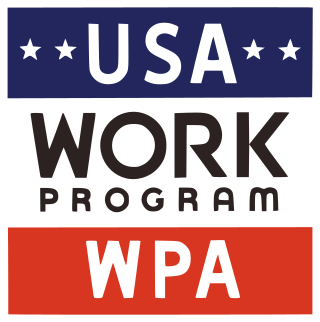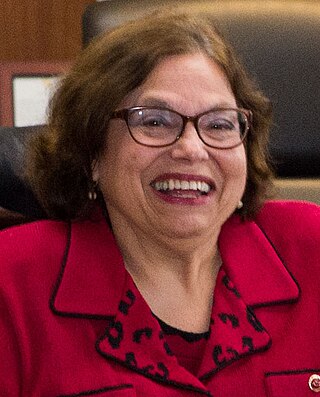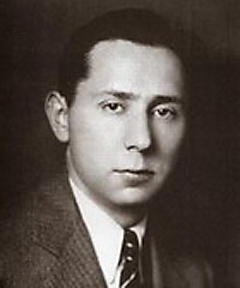Related Research Articles

The Works Progress Administration was an American New Deal agency that employed millions of jobseekers to carry out public works projects, including the construction of public buildings and roads. It was set up on May 6, 1935, by presidential order, as a key part of the Second New Deal.

The disability rights movement is a global social movement that seeks to secure equal opportunities and equal rights for all people with disabilities.

A sit-in or sit-down is a form of direct action that involves one or more people occupying an area for a protest, often to promote political, social, or economic change. The protestors gather conspicuously in a space or building, refusing to move unless their demands are met. The often clearly visible demonstrations are intended to spread awareness among the public, or disrupt the goings-on of the protested organisation. Lunch counter sit-ins were a nonviolent form of protest used to oppose segregation during the civil rights movement, and often provoked heckling and violence from those opposed to their message.

Judith Ellen "Judy" Heumann is an American disability rights activist. She is recognized internationally as a leader in the disability community. Heumann is a lifelong civil rights advocate for people with disabilities. Her work with governments and non governmental organizations (NGOs), non-profits, and various other disability interest groups, has produced significant contributions since the 1970s to the development of human rights legislation and policies benefiting children and adults with disabilities. Through her work in the World Bank and the State Department, Heumann led the mainstreaming of disability rights into international development. Her contributions extended the international reach of the independent living movement.

Disabled In Action of Metropolitan New York (DIA) is a civil rights organization, based in New York City, committed to ending discrimination against people with disabilities through litigation and demonstrations. It was founded in 1970 by Judith E. Heumann and her friends Denise McQuade, Bobbi Linn, Frieda Tankas, Fred Francis, Pat Figueroa, possibly Larry Weissberger, Susan Marcus, Jimmy Lynch and Roni Stier. Heumann had met some of the others at Camp Jened, a camp for children with disabilities. Disabled In Action is a democratic, not-for-profit, tax-exempt, membership organization. Disabled In Action consists primarily of and is directed by people with disabilities.
Sandra Schnur was a pioneer American disability rights leader and author, working mainly in New York City.

David Lasser was an American writer and political activist. Lasser is remembered as one of the most influential figures of early science fiction writing, working closely with Hugo Gernsback. He was also heavily involved in the workers’ rights struggles of the Great Depression.
Section 504 of the Rehabilitation Act of 1973, is American legislation that guarantees certain rights to people with disabilities. It was one of the first U.S. federal civil rights laws offering protection for people with disabilities. It set precedents for subsequent legislation for people with disabilities, including the Virginians with Disabilities Act in 1985 and the Americans with Disabilities Act in 1990.
The depiction of disability in the media plays a major role in molding the public perception of disability. Perceptions portrayed in the media directly influence the way people with disabilities are treated in current society. "[Media platforms] have been cited as a key site for the reinforcement of negative images and ideas in regard to people with disabilities."
Paul K. Longmore was a professor of history, an author, and a notable disability activist who taught at San Francisco State University.
Lives Worth Living is a 2011 documentary film directed by Eric Neudel and produced by Alison Gilkey, and broadcast by PBS through ITVS, as part of the Independent Lens series. The film is the first television chronicle of the history of the American disability rights movement from the post-World War II era until the passage of the Americans with Disabilities Act (ADA) in 1990.
Frieda Zames was an American disability rights activist and mathematics professor. With her sister, Doris Zames Fleischer, Zames wrote The Disability Rights Movement: From Charity to Confrontation, a historical survey that has been used as a disability rights textbook.
Gunnar Dybwad (1909–2001) was an American professor and advocate for the rights of people with disabilities, particularly developmental disabilities. He is best known for his support for the social model of disability, reframing disability accommodations as a matter of civil rights, not medical treatment. The American Association on Intellectual and Developmental Disabilities gives out the Dybwad Humanitarian Award annually in his honor.

The Artists Union or Artists' Union was a short-lived union of artists in New York City in the years of the Great Depression. It was influential in the establishment of both the Public Works of Art Project in December 1933 and the Federal Art Project of the Works Progress Administration in August 1935. It functioned as the principal meeting-place for artists in the city in the 1930s, and thus had far-ranging effects on the social history of the arts in America.

The Workers Alliance of America (WAA) was a Popular Front era political organization established in March 1935 in the United States which united several efforts to mobilize unemployed workers under a single banner. Founded by the Socialist Party of America (SPA), the Workers Alliance was later joined by the Unemployed Councils of the USA, a mass organization of the Communist Party USA (CPUSA), and by the National Unemployed Leagues originating with A.J. Muste's Conference for Progressive Labor Action (CPLA) and successor organizations.
The 504 Sit-in was a disability rights protest that began on April 5, 1977. People with disabilities and the disability community occupied federal buildings in the United States in order to push the issuance of long-delayed regulations regarding Section 504 of the Rehabilitation Act of 1973. Prior to the 1990 enactment of the Americans with Disabilities Act, the Rehabilitation Act was the most important disability rights legislation in the United States.

Marilyn E. Saviola was an American disability rights activist, executive director of the Center for the Independence of the Disabled in New York from 1983 to 1999, and vice president of Independence Care System after 2000. Saviola, a polio survivor from Manhattan, New York, is known nationally within the disability rights movement for her advocacy for people with disabilities and had accepted many awards and honors for her work.

Eunice K. Fiorito was an American disability rights activist and social worker. She was president of the American Coalition of Citizens with Disabilities (ACCD).

In the United States, reserved spaces are mandated by the Americans with Disabilities Act Accessibility Guidelines.
References
- ↑ Longmore, PK; Goldberger, David (December 2000). "The League of the Physically Handicapped and the Great Depression: A Case Study in the New Disability History". The Journal of American History. 87 (3): 888–922. doi:10.2307/2675276. JSTOR 2675276. PMID 17639642.
- 1 2 Rosenthal, Keith. "Pioneers in the fight for disability rights The League of the Physically Handicapped". International Socialist Review. Retrieved 29 April 2018.
- ↑ "The Brooklyn Daily Eagle from Brooklyn, New York on May 13, 1936 · Page 4". Newspapers.com.
- ↑ Rosenthal, Keith. "Pioneers in the fight for disability rights | International Socialist Review". isreview.org.
- ↑ "PLEA BY DISABLED PUT TO WPA CHIEF; New York Group, Camping in Washington, Will Consult Williams Again Today". August 17, 1937. Retrieved 29 April 2018.
- ↑ Fleischer, Doris Zames; Zames, Frieda (2001). The Disability Rights Movement: From Charity to Confrontation . Philadelphia: Temple University Press. p. 906. ISBN 1439907447.
- ↑ "Disability History Timeline". Rehabilitation Research & Training Center on Independent Living Management. Temple University. Archived from the original on 20 December 2013. Retrieved 23 January 2017.
- ↑ Longmore, PK (January 2000). "Disability Policy and Politics: Considering Consumer Influence". Journal of Disability Policy Studies. 11 (1): 36–44. doi:10.1177/104420730001100111. S2CID 145123577.